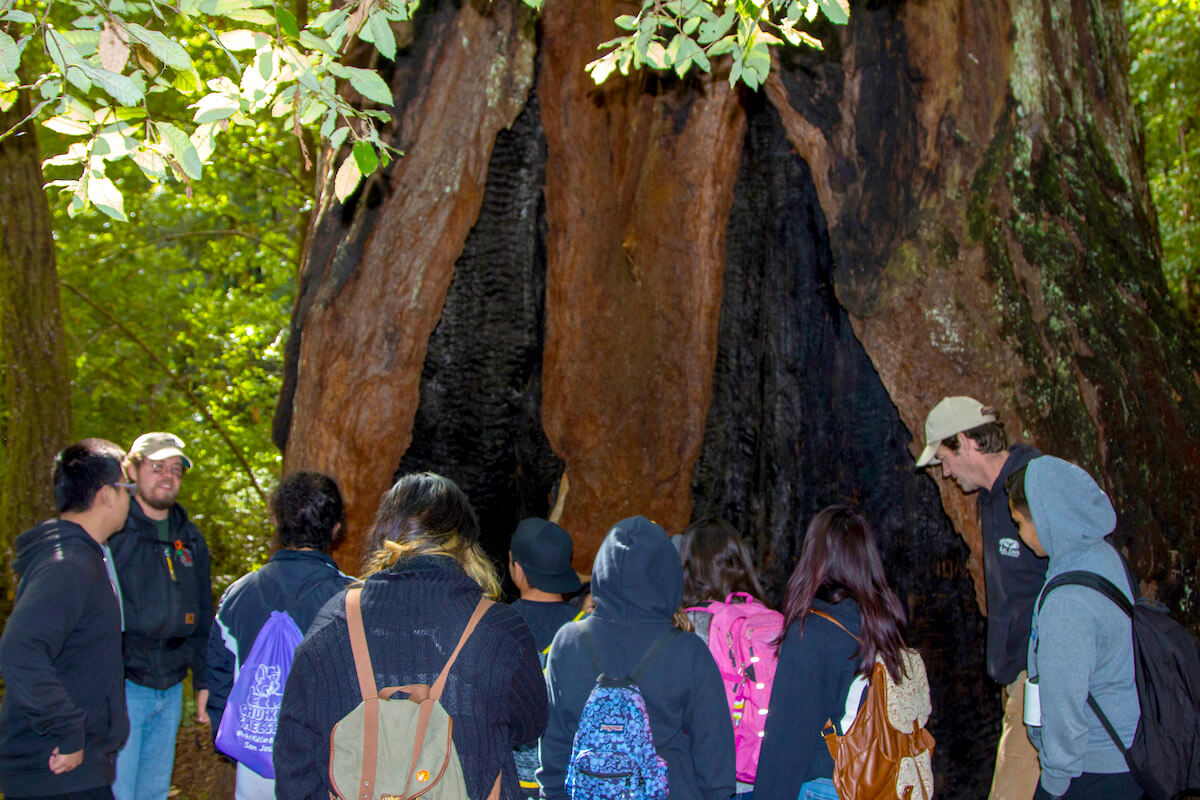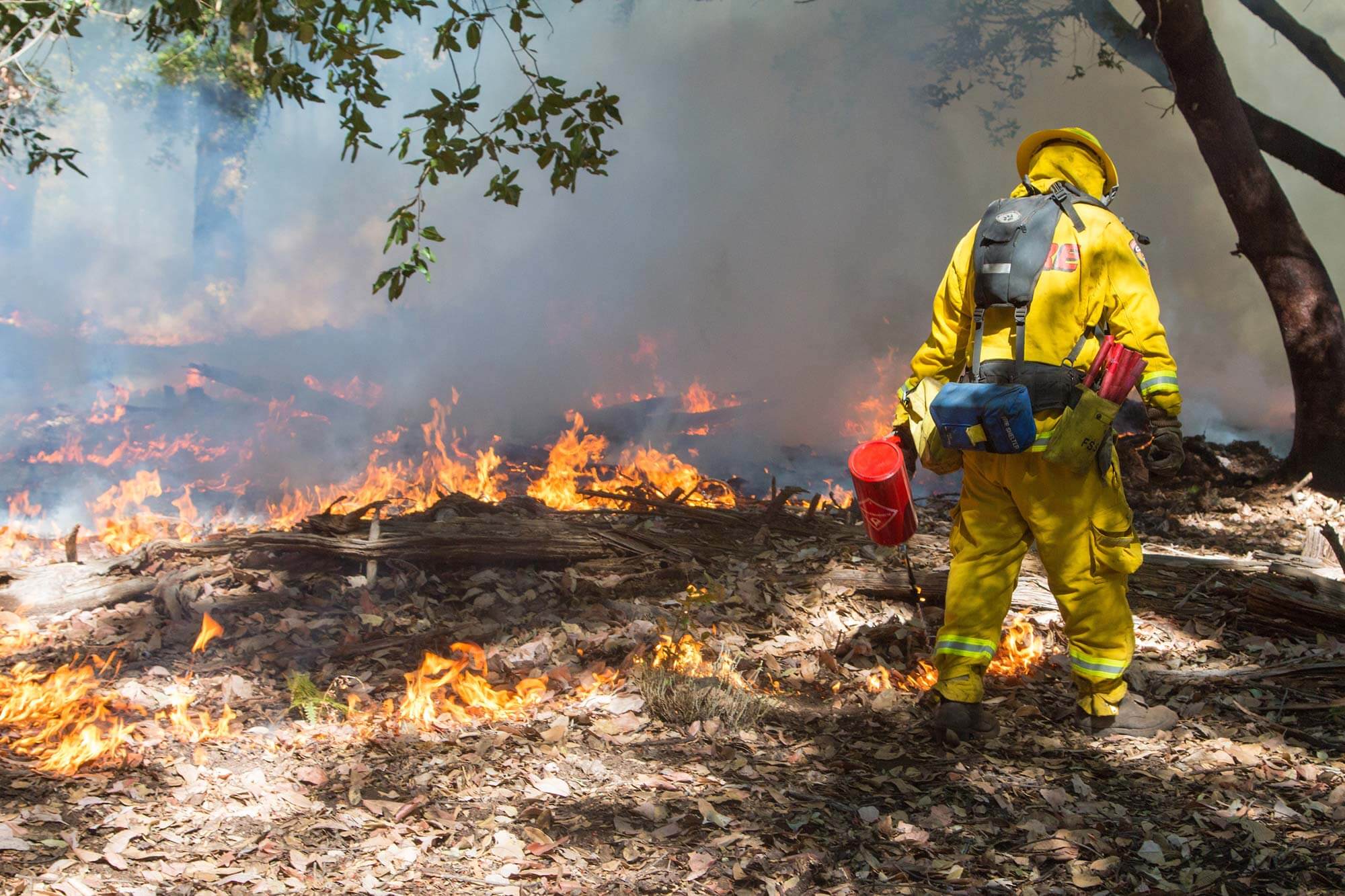How Redwoods Survive Wildfire

A school group investigates a living old-growth redwood with major fire scars in Big Basin Redwoods State Park. Photo by Mike Kahn/Sempervirens Fund
With our recent terrible years of wildfires here in California and around the globe, many people have been concerned about how redwoods survive wildfire. We are very fortunate that redwoods are incredibly resilient trees, a fact that helps them live to over two thousand years old (redwood tree facts) and one of the characteristics of identifying old-growth redwoods are signs of fire scarring. Here are key features that help redwoods survive wildfires:
- Tannin – Coast redwoods contain a significant amount of the chemical tannin in their bark and in their heartwood. Tannin does not burn easily–a natural flame retardant. It’s the tannin that gives redwoods their reddish color and also protects them against disease, fungi, and insects. Redwoods also have little resin or pitch, which are highly flammable, and lead other types of trees like tanoaks, firs, and pines to burn much quicker.
- Bark – The bark of mature redwood trees can grow at least a foot thick, creating a great protective shield from fires. This helps prevent fire from getting to the more easily burned sapwood behind the bark. This bark has high water content, which also helps prevent it from burning easily.
- Height – Redwoods are the tallest trees in the world. Being so tall helps prevent most wildfires from spreading up into the tops of the trees, where their needles soak in sunlight and moisture to keep the tree alive.
- Needles – Redwoods have needles that are broader and flatter than most conifers, allowing them to catch fog and creating fog drip that reaches down to the forest floor. The fog drip is not only essential for many of the understory plants, but also helps keep areas moister during typically dry summer months on the coast, reducing fire ignition, spread, and intensity.
Young redwoods that do not yet have thick bark and aren’t as tall are much more susceptible to dying in wildfires. However, this allows for the larger, older redwoods that do survive to have more space and light to grow bigger.
Despite the resiliency of redwoods, there are many factors that are increasing wildfire danger and putting communities and forests at greater risk. Hotter, dryer conditions, more dead trees due to sudden oak death, and fire suppression that leaves more fuels on the ground all lead to more intense wildfires. With more intense fires, even large mature redwoods can be killed more easily with the great heat and higher potential for flames to get into the upper reaches of the trees.

Cal Fire performs a prescribed burn at San Vicente Redwoods to increase fire safety. Photo by Mike Kahn/Sempervirens Fund
Sempervirens Fund works with Cal Fire, local Fire Safe Councils, and other agencies and organizations to help mitigate fire risks on our properties and throughout the Santa Cruz Mountains. Here are some of the strategies we use to prevent catastrophic wildfire and help redwoods survive:
- Fuel Breaks – By thinning or removing understory vegetation in key areas, often along roads, ridgelines, and new communities, fuel breaks create areas with less material for a wildfire to burn which can provide firefighters an opportunity to contain its spread or even stop it in its tracks.
- Prescribed burns – A carefully managed prescribed burn can reduce the amount of vegetation and fuels in an area to slow the spread and intensity of an approaching wildfire, while also providing numerous benefits to the fire-adapted habitats of California.
- Infrastructure – Access and resources are key for fighting a fire, and maintaining roads for quick response, placing water tanks in strategic areas, and creating viable helicopter landing zones are critical ways we help support firefighters.
- Restoration forestry – Sempervirens is also initiating restoration forestry projects to thin forests that have become overcrowded as a result of past clear-cut logging and historic fire suppression. This can create better spacing to slow how fast a fire can spread between trees, while also accelerating the development of larger, more fire-resilient trees.
These actions are a critical part of protecting the redwood forests and other habitats of the Santa Cruz Mountains we love in the face of climate change’s increasing impact on wildfire behavior.
We are grateful for our donors’ support without which none of this work would be possible.
Additional Resources
- Fire Safe Santa Cruz County
- Cal Fire – Ready for Wildfires
- Amah Mutsun Tribal Band – Prescribed fire at San Vicente Redwoods
- How will California prevent more mega-wildfire disasters? (National Geographic, 12/20/19)
- What are California megafires? Things to know (Knowable Magazine, 11/20/2019)
- Wildfires in California – Friend or Foe (Scott Stephens | TEDxBerkeley, 4/23/2019)
- Megafires: Controlled burns could reduce destructive, out of control blazes (The Mercury News, 9/9/18)


